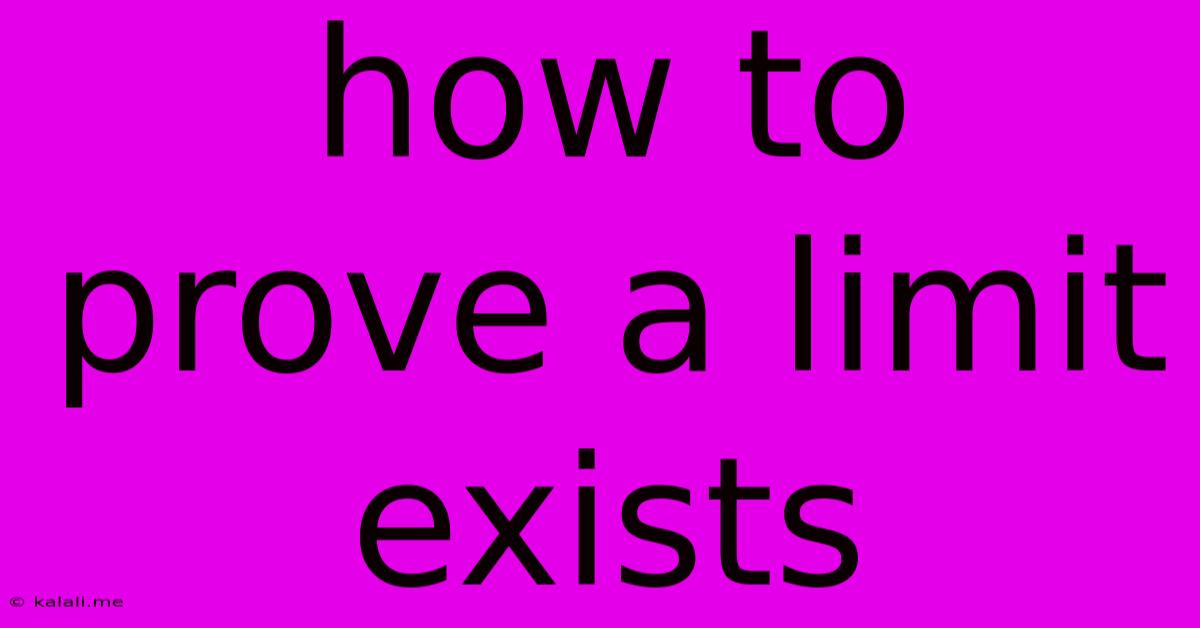How To Prove A Limit Exists
Kalali
Jun 02, 2025 · 3 min read

Table of Contents
How to Prove a Limit Exists: A Comprehensive Guide
Meta Description: Learn how to rigorously prove the existence of a limit using the epsilon-delta definition, exploring various techniques and examples to solidify your understanding. Master limit proofs and conquer calculus!
Determining whether a limit exists is a fundamental concept in calculus. While intuition often suggests the limit's value, a rigorous mathematical proof is necessary for certainty. This guide explores different approaches to proving the existence of a limit, focusing on the epsilon-delta definition, a cornerstone of real analysis.
Understanding the Epsilon-Delta Definition
The epsilon-delta definition of a limit formally states:
For a function f(x), the limit as x approaches a is L (written as lim<sub>x→a</sub> f(x) = L) if and only if for every ε > 0, there exists a δ > 0 such that if 0 < |x - a| < δ, then |f(x) - L| < ε.
Let's break this down:
- ε (epsilon): Represents a small positive number, defining a tolerance around the limit L. It dictates how close f(x) needs to be to L.
- δ (delta): Represents another small positive number, defining an interval around a. It controls how close x needs to be to a to ensure f(x) is within ε of L.
- 0 < |x - a| < δ: This ensures we're considering values of x close to a, but not a itself (as the function's behavior at a is irrelevant for the limit).
The core idea is to find a δ for any given ε, proving that we can always get f(x) arbitrarily close to L by choosing x sufficiently close to a.
Proving Limit Existence: A Step-by-Step Approach
The process typically involves these steps:
-
Start with the goal: Begin with the inequality |f(x) - L| < ε. This is what we want to show.
-
Manipulate the expression: Use algebraic techniques (e.g., factoring, simplifying, adding and subtracting terms) to relate |f(x) - L| to |x - a|. The goal is to obtain an inequality of the form |f(x) - L| < some expression involving |x - a|.
-
Find a suitable δ: Determine a δ that guarantees |f(x) - L| < ε whenever 0 < |x - a| < δ. This δ will often depend on ε.
-
Write the formal proof: Structure your proof clearly, stating the given ε, finding the corresponding δ, and showing that if 0 < |x - a| < δ, then |f(x) - L| < ε.
Examples:
Example 1: Proving lim<sub>x→2</sub> (3x - 1) = 5
-
Goal: |(3x - 1) - 5| < ε
-
Manipulation: |3x - 6| < ε => 3|x - 2| < ε => |x - 2| < ε/3
-
Suitable δ: Choose δ = ε/3.
-
Proof: Let ε > 0 be given. Choose δ = ε/3. If 0 < |x - 2| < δ, then |(3x - 1) - 5| = |3x - 6| = 3|x - 2| < 3(ε/3) = ε. Therefore, lim<sub>x→2</sub> (3x - 1) = 5.
Example 2: A More Complex Case
Proving limits of more complex functions often requires more intricate algebraic manipulation and potentially the use of inequalities like the triangle inequality (|a + b| ≤ |a| + |b|).
Alternative Approaches and Considerations
While the epsilon-delta definition provides the most rigorous approach, other techniques can be helpful:
-
Limit Laws: For simpler functions, limit laws (sum, difference, product, quotient, etc.) can significantly simplify the proof. However, always remember these laws require the individual limits to exist.
-
Squeeze Theorem: If a function is "squeezed" between two functions with the same limit, then the function also has that limit.
-
Sequential Criterion for Limits: This alternative definition states that a limit exists if and only if the function's values converge to the limit along every sequence converging to the point.
Mastering limit proofs requires practice. Start with simpler examples and gradually move towards more challenging ones. Remember to break down the problem systematically and clearly communicate each step in your proof. Understanding the epsilon-delta definition is crucial for a solid grasp of calculus and real analysis.
Latest Posts
Latest Posts
-
Joshua Prostrated Himself Before The Warrior
Jun 04, 2025
-
How To Dispose Of Old Knives
Jun 04, 2025
-
Turn Order For A 4 Way Stop
Jun 04, 2025
-
Why Do Dogs Lick Other Dogs Mouths
Jun 04, 2025
-
How To Replace A Water Heater Element
Jun 04, 2025
Related Post
Thank you for visiting our website which covers about How To Prove A Limit Exists . We hope the information provided has been useful to you. Feel free to contact us if you have any questions or need further assistance. See you next time and don't miss to bookmark.